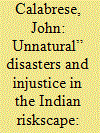|
|
|
Sort Order |
|
|
|
Items / Page
|
|
|
|
|
|
|
| Srl | Item |
| 1 |
ID:
171907


|
|
|
|
|
| Summary/Abstract |
The 2011 Bangkok floods, a slow onset event, flooded significant parts of the city. The state's response to flooding followed a traditional cultural and hierarchical approach to justice within Thailand, stemming from Buddhist values, an informal caste system and monarchical order. This resulted in a spatially uneven outcome, with the ‘preservation’ of the central city and two‐month‐long floods in outer suburbs, exacerbated by inadequate management and coordination. Suburban communities sought a more egalitarian notion of disaster justice, with hazard burdens shared more equitably and people having adequate access to decision‐making over the distribution of disaster risk and compensation for damage. Extensive damage, and reduced livelihoods, caused friction between the two views, and protests, contestations and conflicts during the floods, in four different community contexts in northern Bangkok. By generating alternative discourses, challenging the hierarchical notion of justice and taking direct action to removing floodwalls, protesters sought to reshape the spatiality of the floodwater and claim inclusive citizenship and their right to the city. Existing perceptions of disaster justice, usually focused on liberal state responses to understanding disasters as natural episodes, are alone inadequate to explain the outcomes of and responses to disasters in different cultural contexts.
|
|
|
|
|
|
|
|
|
|
|
|
|
|
|
|
| 2 |
ID:
182838


|
|
|
|
|
| Summary/Abstract |
The vulnerabilities that turn natural hazards such as hurricanes and earthquakes into disasters are rooted in inequality. The overarching aim of this article is to shed light on the nexus between social justice principles and the mitigation of disaster impacts. The article uses ‘disaster justice’ – an offshoot of ‘environmental justice’ – as a conceptual lens to help enrich understanding of the differential impacts of disasters upon communities and to craft more inclusive policies and programmes. In India, among the world's most disaster-prone countries, as elsewhere, there is growing recognition that children and youth, who assume a disproportionate share of the burden created by disasters, are an underutilized demographic force multipliers for disaster risk reduction. The country's multi-hazard risk and vulnerability profile has led Indian non-governmental organisations (NGOs) not just to provide post-disaster relief but increasingly to integrate into their work programs designed to unleash the potential of young people to develop the resilience of their communities.
|
|
|
|
|
|
|
|
|
|
|
|
|
|
|
|
|
|
|
|
|